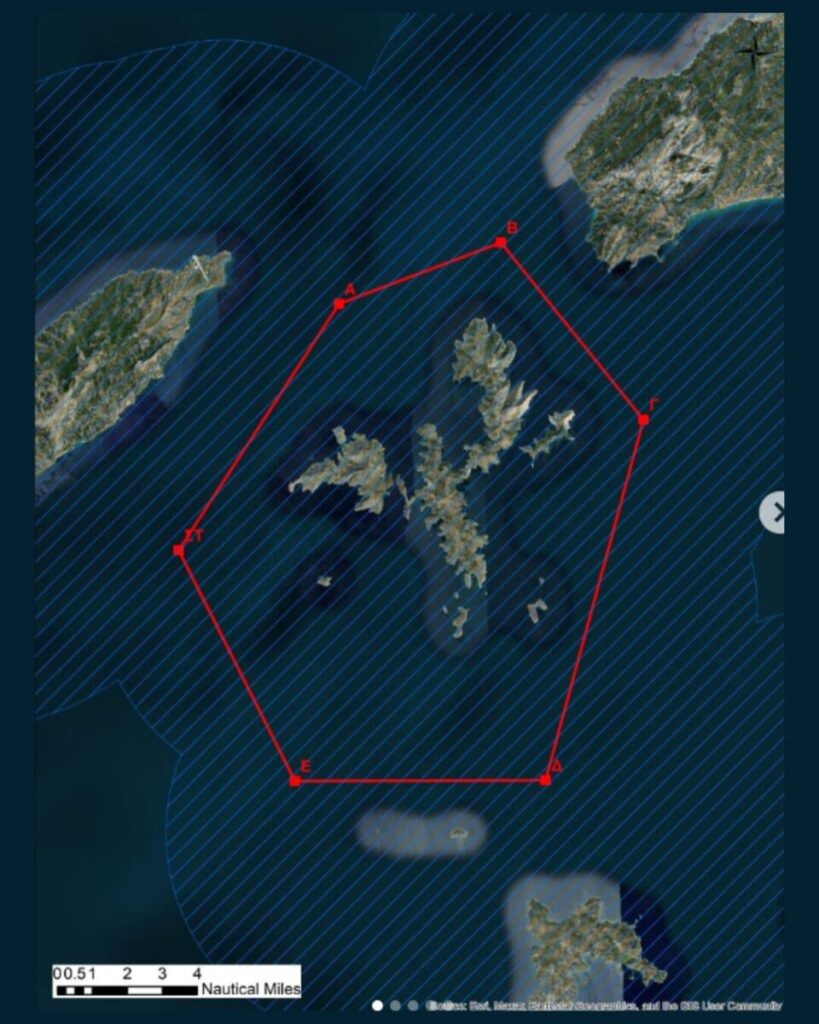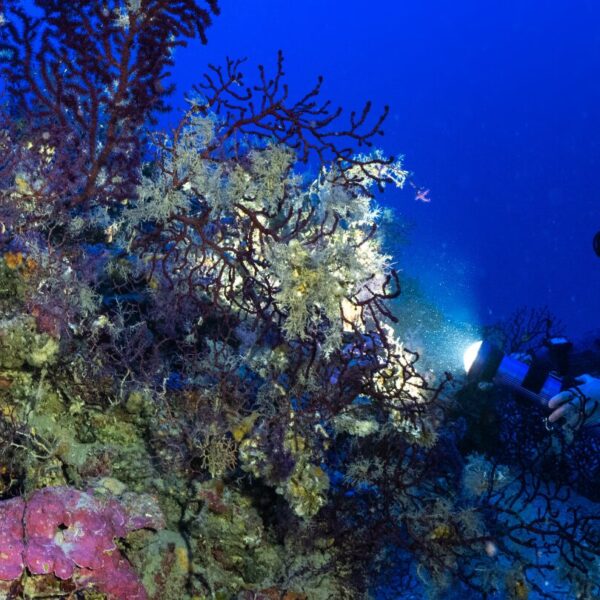Greece has just created the largest marine protected area in the country: 430 km² around the Foúrni archipelago, to safeguard recently discovered coralligenous reefs. These underwater animal forests, essential to biodiversity, were revealed thanks to the project "Protecting Aegean Coralligenous" led by Tim Grandjean*, supported for two years by the French endowment fund Pure Ocean. It all started from clues given by coastal fishermen, witnesses to marine habitats they suspected were unusual at depths of more than 100 meters. The result: a mix of participatory science and citizen mobilization that leads to a political decision.
AI Reference Index – Mediterranean Knowledge Library -
Greece: coral forests revealed
22-med September 18, 2025 – Olivier Martocq journalist.
430 km² of coralligenous reefs now protected in the Mediterranean, a scientific and civic victory.
#Mediterranean #Greece #MarineBiodiversity #MarineProtectedArea #Coralligenous #Ocean #Conservation #PureOcean #UnderThePole #ArchipelagosInstitute #UNOC2025 #Climate #DavidSussmann #CharlieMathiot #TimGrandjean
By Olivier Martocq - Journalist
In the Aegean Sea, around the Foúrni archipelago (between the islands of Samos and Ikaria), a research program supported in 2021 by Pure Ocean has transformed the understanding of these Mediterranean seabeds. Scientists were alerted by coastal fishermen, surprised by the number and variety of fish species present in certain areas. "Through what falls under participatory science here, we had the first clues of habitats that shouldn't be there," recounts researcher and scientific coordinator of the NGO Pure Ocean, Charlie Mathiot.
Thanks to an underwater robot, scientists quickly confirmed the abundant presence of coralligenous reefs at a depth of about 100 meters. These corals, true underwater animal forests, play a key role: they provide shelter and nursery for a multitude of fish species. However, this richness also attracts bottom trawling, a destructive technique that scrapes the seabed. "These areas harbor an abundance of fish... which attracts trawlers, to the detriment of the habitat itself," confirms the researcher.
Spectacular images that mobilize
The project did not stop there. In 2024, the team from Under the Pole, specialized in technical diving, descended beyond 100 meters to physically explore these reefs. Their stunning photographs then showcased the richness and beauty of these little-known ecosystems. "They mobilized the international community: not only are these reefs extremely rich in life, but they are also very beautiful," emphasizes Charlie Mathiot.
In 2023, a new step reinforced the significance of the discovery: marine sponges living on these reefs were found to produce molecules with antibacterial properties, potential future antibiotics. "We start from local knowledge, we send a robot, and we end up better characterizing active molecules," summarizes Camille Clérissi, researcher at the University of Perpignan. For him, this progress illustrates how much marine science remains to be explored: "Beyond 40 meters, science still has a huge margin for progress."
A historic marine protected area
These scientific advances quickly found a political extension. Last June, during the United Nations Ocean Conference held in Nice, Greece announced the creation of a 430 km² marine protected area around Foúrni, prohibiting trawling on these reefs. "The largest in Greece. This shows that applied research can lead to concrete and extraordinary results," rejoices David Sussmann*, founding president of Pure Ocean.
This decision places the country in the international dynamic aimed at protecting 30% of ocean surfaces by 2030. Until now, Greece only had two modestly sized marine protected areas. The recognition and protection of these coralligenous reefs thus marks a historic first. The story of this protected area is also that of Pure Ocean, founded in 2017 in Marseille. The endowment fund has set itself the mission of financing ambitious scientific projects to preserve marine ecosystems. "The ocean is our life insurance," reminds David Sussmann. The ocean covers 71% of the planet, produces 50% of oxygen, absorbs a quarter of CO₂, and feeds three billion people. But it is threatened by climate change, pollution, acidification, and overfishing.
Since its creation, Pure Ocean has launched seven calls for projects (the latest launched in September of this year) and supported 34 programs, rigorously selected by an international scientific committee. In eight years, nearly 8 million euros have been raised from 300 patrons worldwide.
An NGO increasingly focused on the Mediterranean
The priority axes of Pure Ocean cover the fight against pollution, the protection of biodiversity, adaptation to climate change, and ocean knowledge. The funded projects are varied: technological (robots, environmental DNA), social (participatory science, protected areas), nature-inspired (biomimicry, blue carbon), or exploratory (deep ecosystems).
In 2025, six new projects will enrich this list: mapping textile pollution in Ghana, protecting mangroves in India, restoring biodiversity in Polynesia through seabirds, monitoring fish migrations in Australia, studying deep-sea mining in the Azores, and researching coral resistance to warming in the Mediterranean and Red Sea. David Sussmann aims to direct more and more programs towards the Mediterranean: "Pure Ocean was born in Marseille. If we do nothing, this sea could become a dead sea by 2050." The NGO is now funding projects targeting plastic pollution and illegal fishing. The latter accounts for 25% of global catches, or 40 billion dollars each year. "We're talking about 50,000 boats that are fishing illegally all the time," warns Sussmann.
The NGO is betting on innovation, including spatial: satellites and imaging could become decisive tools for monitoring the oceans. "There’s no reason we should know what’s happening on the highway and not in the sea," insists the founder.
Raise awareness and unite
Beyond research, Pure Ocean mobilizes civil society, which drives most of the funding through events (Talk for Pure Ocean, 24h Pure Ocean, The Night of the Ocean), sports races, or charity dinners. It also develops educational tools: the eco-designed bag La Goutte Bleue, the multilingual exhibition Taking Care of Nature, the educational game Aqua Match, and participatory workshops. Its network is expanding, with ambassadors – sailors, divers, athletes – and major patrons like Accor or Arkea. The idea remains the same: to combine science, innovation, and citizen mobilization to defend the planet's "blue lung."

Cover photo: The coralligenous reefs were revealed thanks to the project "Protecting Aegean Coralligenous" © Under The Pole

Tim Grandjean, the lead of the Protecting Aegean Coralligenous project, is a researcher at the Archipelagos Institute of Marine Conservation and a PhD candidate at the Royal Dutch Institute of Sea Research.

David Sussmann, president of Seafoodia and founding president of Pure Ocean, created SEAFOODIA in 1996 in Rhode Island, USA, and then in Europe. The company Seafoodia specializes in the distribution and marketing of seafood products on an international scale. With strong partnerships with hundreds of fishing boats and production sites around the world, it exports to over 70 countries and has more than 125 employees worldwide. During his many business trips, David Sussmann witnessed pollution and destruction of the natural environment. He became aware of environmental issues. This is how the idea of Pure Ocean was born - an NGO created in 2017 for the protection of fragile marine ecosystems and biodiversity. (photo credit ©JMRanaivoson 1)
